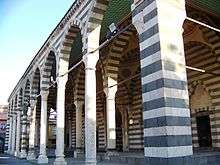Behram Pasha Mosque
Behrem Pasha Mosque (Turkish: Behrem Paşa Camii, Kurdish: Mizgefta Behram Paşa) is a 16th-century Ottoman mosque located in the town of Diyarbakır in southeast Turkey. It was commissioned by the Ottoman governor-general Behram Pasha and designed by the imperial architect Mimar Sinan.
| Behrem Pasha Mosque | |
|---|---|
Behram Paşa Camii Mizgefta Behram Paşa | |
 | |
| Religion | |
| Affiliation | Islam |
| Location | |
| Location | Ziyagökalp, Diyarbakır, Turkey |
 Location within Turkey | |
| Geographic coordinates | 37.9094°N 40.2342°E |
| Architecture | |
| Architect(s) | Mimar Sinan |
| Type | Mosque |
| Style | Ottoman architecture |
| Groundbreaking | c. 1564/65 |
| Completed | 1572/73 |
| Specifications | |
| Dome dia. (outer) | 15.9 m (52 ft) |
| Minaret(s) | 1 |
| Materials | alternating layers of white limestone and black basalt |
History
The mosque was commissioned by the local Ottoman governor-general Behram Pasha. He was the son of Kara Şahin Mustafa Pasha who served as the governor-general of Yemen and Egypt. The dates of Behram Pasha's tenure in Diyarbakır are uncertain but were probably between 1564-65 and 1567–68. He died in 1585 and was buried in Aleppo.[1] The mosque was designed by the imperial architect Mimar Sinan. Building began in around 1564-65 and was completed by 1572-73 (AH 980), the date included in the Arabic inscription carved above the entrance portal.[2]
Architecture
Exterior
An octagonal drinking fountain is aligned with the central portal of the north façade. The pyramidal roof of the fountain is supported by composite black and white columns with braided central sections. The north façade of the mosque is constructed in alternation layers of black and white stone. The double portico has five domes. The two central columns supporting the outer portico have a braided central section placed between alternating layers of black and white stone, echoing those of the fountain. The remaining columns supporting the portico are of white marble. A single minaret sits at the northwest corner of the portico. The mosque itself is in the form of an unlayered domed cube. The dome sits on a sixteen-sided drum which has windows on each of the sides.[2]
Interior
The 15.9 metres (52 ft) diameter dome is supported by eight pointed arches. The dados of the prayer hall are decorated with large square polychrome underglazed tiles. These have a border of two styles of rectangular tiles. The tiles are believed to have been produced locally in Diyarbakır but are very similar to those produced in İznik.[2]
The design of the mosque has been praised by architectural historians.[2] Godfrey Goodwin wrote in 1971: "It is, indeed, the prince of provincial mosques as splendid in its decoration as it is in its proportions within the limits of the severe local style."[3]
Gallery
 Diyarbakır Behram Pasha Mosque Exterior
Diyarbakır Behram Pasha Mosque Exterior Diyarbakır Behram Pasha Mosque Exterior
Diyarbakır Behram Pasha Mosque Exterior Diyarbakır Behram Pasha Mosque Exterior
Diyarbakır Behram Pasha Mosque Exterior Diyarbakır Behram Pasha Mosque Exterior
Diyarbakır Behram Pasha Mosque Exterior Diyarbakır Behram Pasha Mosque Exterior
Diyarbakır Behram Pasha Mosque Exterior Diyarbakır Behram Pasha Mosque Interior
Diyarbakır Behram Pasha Mosque Interior Diyarbakır Behram Pasha Mosque Minber
Diyarbakır Behram Pasha Mosque Minber
References
- Necipoğlu 2005, p. 467.
- Necipoğlu 2005, p. 468.
- Goodwin 2003, p. 310.
Sources
- Goodwin, Godfrey (2003) [1971]. A History of Ottoman Architecture. London: Thames & Hudson. ISBN 978-0-500-27429-3.CS1 maint: ref=harv (link)
- Necipoğlu, Gülru (2005). The Age of Sinan: Architectural Culture in the Ottoman Empire. London: Reaktion Books. ISBN 978-1-86189-253-9.CS1 maint: ref=harv (link)
Further reading
- Raby, J. (1977–78). "Diyarbakir: a rival to İznik. A sixteenth-century tile industry in eastern Anatolia". Istanbuler Mitteilungen. 27: 429–459.CS1 maint: date format (link)
External links
| Wikimedia Commons has media related to Behram Pasha Mosque. |
- Behram Paşa Camii, Archnet

